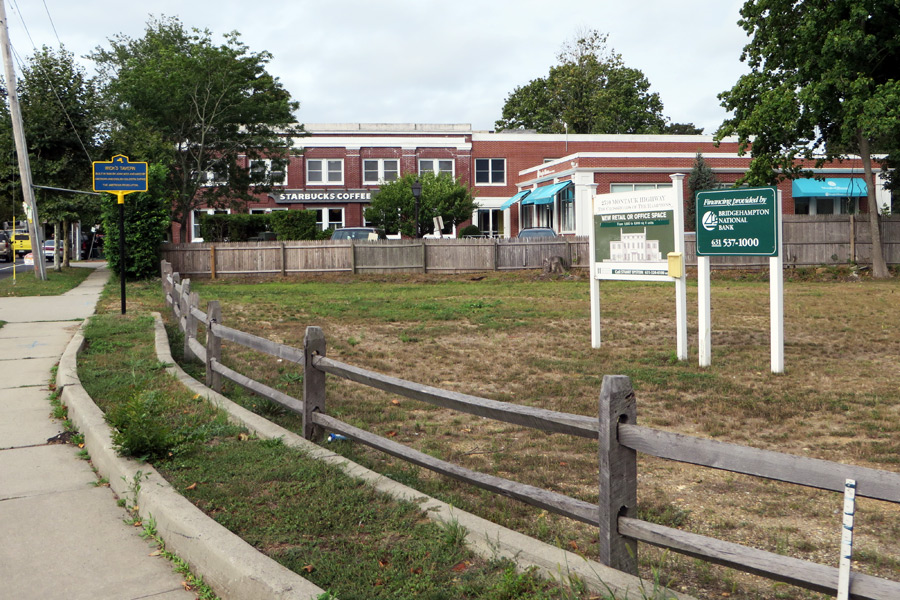Build a CVS or a Park Honoring Bridgehampton in the Revolutionary War?

For four months now, many residents of Bridgehampton have been fighting to keep a CVS store from opening on Main Street in that town. They have demonstrated on Saturday mornings, sometimes as many as 25 of them, carrying signs and standing on the street corner where the store would be built asking motorists to honk if they agree. The corner is at the very center of downtown, facing out toward the Founders Monument in the middle of Main Street. If built on this site, the CVS would be in a new building, two stories tall. Whether it gets built or not is a very important decision, and I think it will be made in the next two months.
I believe this building should not be built. I think what it should be is a historic site that tells the story of Bridgehampton’s role in the Revolutionary War. The property, currently vacant, was home to the historic Wick’s Tavern, where those committed to the rebellion are said to have often met. (At the time, the Hamptons was occupied by the British and largely sympathetic to the British.) The tavern stood for three centuries on that site and was torn down in 1941 to make way for a Shell gas station, which was later converted to a beer and soda store that was also torn down in 2008.
There was a barn that stood behind Wick’s Tavern and it survives—it sits in pieces, unused and saved across the street in numbered pieces in back of the Nathaniel Rodgers House. It could be easily moved to the site and it could serve as a museum, perhaps an open-air one, which would celebrate Wick’s Tavern and the role it played. That would leave room for benches and a park. And it would also allow for a description, perhaps inside the barn, of the activities of the Bridgehampton Militia, which mustered on what was then open land directly across the street during the Revolution. Members of that militia went on to enlist and then marched upstate to be part of the defense of Fort Ticonderoga, and they ultimately escorted British Redcoats down to New York City when that battle ended.
In all the Hamptons, this was the only site where the local militias, Bridgehampton and others, trained to fight to create this country. And nowhere, except in history books and in a little-known quarter-acre park behind Almond restaurant across the street is this history currently available to the general public. It’s a story that deserves to be told. Furthermore, a famous flag, the Hulbert Flag, thought to have been used by that militia and found in an attic in Bridgehampton, survives. But it is in a museum in Riverhead.
If a decision is made to allow the CVS to come to that corner, this will end forever the chance to report this history alive in the center of Bridgehampton where it all occurred. It is no small thing.
I should like to say that, as this story has unfolded in the last few months, I had at first thought having that building for CVS on the corner there was a good thing. It would make Bridgehampton into a true commercial center after years and years of the town playing second fiddle to Southampton and East Hampton. And the building, its design already approved by the Southampton Planning Board, would be worthy of the center of town. The property owner, who tore down that abandoned gas station/beverage barn, had gotten the town to approve the construction of a beautiful two-story structure of 19th-century Greek Revival design with white columns facing out front toward the monument. This would, even as a CVS, complement the 19th-century Topping Rose House on the northeast corner and the 19th-century Hopping House (aka Nathaniel Rodgers House) on the southeast corner, both of which have columns out front and are completely restored or almost completely restored. On the fourth corner, where the militia is said to have paraded, there is a white stucco building housing Almond restaurant. And there is nothing that can be done about that.
Therefore, putting a Greek Revival building on this fourth corner, in spite of serious parking problems, was defensible. The Monument would mark the eastern end of town. To the east of that, on the north and south corners, would be the two mansions, one now a public inn and the other about to be a museum. To the west of the monument, and continuing on for four blocks, would be the commercial town. It would be a 21st-century town of some beauty. But it would not be anchored by its history.
It is now possible to see that the Hopping House and the Topping Rose House are not well integrated with the town and are difficult to get to. If, instead, this last corner is made into a small historic park, there is a connection, a public place to look out at those two mansions beyond the monument, thus creating a whole campus of historic buildings of considerable dimension surrounding a memorial.
This a very major consideration. In New England towns, and our towns are very much New England towns, communities have survived with their heritage intact in a downtown historic complex. Hanover, New Hampshire has a thriving center of town, but at one end is the grand town green. Litchfield, Connecticut has a town green that runs as the centerpiece of the commercial district for three blocks.
Here on the East End, East Hampton has kept its historic district intact—the pond, the cemetery, the windmill, the farmhouses—and now here is Bridgehampton, with an opportunity to do the same.
Those of us who have been here for a long time have watched Bridgehampton rise from a town that had been an eyesore. The center of town, 50 years ago, indeed featured the two mansions by the monument. But one mansion was falling apart and the owner of it had rented out his front lawn as a gas station. The other mansion was also abandoned and falling apart. One attempt to revive this second mansion consisted of a proposal by the Sunoco company to build a second new gas station on its front lawn. Imagine this. If the citizenry had failed to rise up against this, there would have been two Greek Revival mansions, each with gas stations on their front lawns, facing each other, while on the third corner, the one under consideration today, there already was a Shell gas station.
And there were more gas stations. Along the four-block Main Street, there were three others—one next to what is now Urban Archeology, one directly across the street from it, and one next to where World Pie is now. All are gone. And the town has prospered and thrived and now has come up to this major decision.
Bridgehampton is a hamlet in the Town of Southampton, and Southampton is awash in Community Preservation Fund (CPF) money it collects as taxes from real estate sales to save open space. It has so much money socked away from this—about $30 million in 2014 alone so far —it doesn’t know what to do with it all.
Based on what people have told me, I am of the belief that this last corner of the center of town can be purchased for about $7 million.
I hope the town does this to complete the creation of a historic centerpiece to Bridgehampton.









